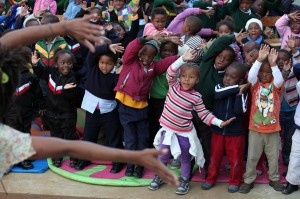 Here are some activities to do with children that can be lots of fun and deepen and extend their experiences of the stories you tell them. Some of the ideas are suitable for all ages, while others are better suited to older children. You might like to choose one or two activities to do with each story you tell.
Here are some activities to do with children that can be lots of fun and deepen and extend their experiences of the stories you tell them. Some of the ideas are suitable for all ages, while others are better suited to older children. You might like to choose one or two activities to do with each story you tell.
Things to do before you tell a story
- Sing a song or say a rhyme linked to the content of the story or one of the story characters.
- Ask your children if they know any other stories about the kinds of characters in the story you are about to tell. (For example: ‘I’m going to tell you about a boy and girl who got lost in a forest. Do you know any stories about boys or girls who get lost?’) Let them tell you what happens in these stories.
- Ask your children if anything like the story you’re about to tell has ever happened to them or someone they know. (For example: ‘Have any of you, or anyone you know ever been lost? What happened? How did you feel?’) .
Things to do during the storytelling
- As you tell the story, stop briefly once or twice to ask, ‘What do you think will happen next?’ This helps to develop your children’s prediction skills, which are important for reading.
- Encourage your children to participate in the telling of the story by making sound effects (for example: knocking on the floor to imitate someone knocking on a door; making the noise of the wind) or using body movements to imitate parts of the story (for example: swaying like trees in the wind; pretending to swim across a river).
Things to do after you have told the story
- Help children make connections between the characters in the story and their own experiences or other stories that they may know which are similar. Many stories focus on how characters deal with challenges that life sends their way. It is helpful for children to relate these things to challenges that they face in their own lives. Encourage them to do this by saying something like, ‘When I tell this story, it reminds me of how important good friends are. What does it remind you of?’
- Children can also learn to develop empathy by putting themselves in a character’s situation. Help them to do this by asking them to think about why they think characters behave in particular ways in the story. Help them consider values by asking them if they would do or say what a character does. Ask them to think of alternative ways that the character might behave.
- Encourage children to interpret the story you have told by asking them to draw or paint a picture of their favourite part of the story.
- Pretend you are an interviewer and ask your children to be different characters from the story. Interview them as if you are a talk show host. This will give your children the chance to think more about a particular character’s personality and their role in the story.
- Let your children lead you in acting out the story to encourage imaginative, creative and strategic thinking. If possible, help them dress up or make or find props to use that make their pretending feel more real such as bags, hats, scarves, gloves, wigs, aprons, coats, jewellery, boxes and blankets.
- Encourage them to improvise and let an old story make new twists and turns: say things like, ‘What if the crafty hyena suddenly arrived carrying a baby on his back and he was crying, “Help, please help!”

